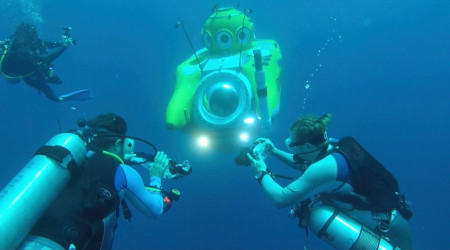Modern Day Explorers Successfully Tag Six Gill Sharks From Homemade Submarine

SEATTLE, January 12, 2022 (Newswire.com) - During the summer of 2021, exploration company ESE, carrying Explorers Club Flag #211, compiled a team of ocean-conscious leaders old and young in an effort to support our understanding of the world nearly half a mile below the surface. Working in conjunction with Dr. Dean Grubbs at Florida State University's Coastal and Marine Laboratory, the crew successfully logged over 50 hours at depth and tagged two deep sea sharks from a three-person submarine. Tracking the first animal for 30 days, the other's whereabouts won't be known for an entire year, until the tracking tag surfaces.
The dive team's data shows the first tag traveling approximately eight nautical miles over the course of a four-week period. During this time they also recorded the sharks' daily vertical migrations ranging from the shallows of 255m (836 ft.) to the depths of 1,114 m. (3,654 ft.). The data was acquired in support of current marine research.
"What else is out there waiting to be discovered?" questions expedition leader Trent Tresch. "It's imperative that we continue to study our oceans and the life in them. By filling our gaps in knowledge, we grow to better understand our planet and subsequently our place on it."
Taking advantage of the novel exploration platform, the team also worked with local plastic scientist Zara Zuniga to engineer a methodology which they believe has allowed them to gather water samples up to depths of 2,000 ft. The samples are currently being verified for microplastics but the team has, unfortunately, identified plastic fibers visually under the microscope.
Additionally, team member Alec Payne is working to identify a remarkable comb jelly that was observed on one dive. Judging from its unique morphology, it represents a species not yet described in the scientific literature. He states, "The closest [potential taxon] could be the genus Euplokamis, but it doesn't have the right tentilla structure." Top experts in invertebrate marine biology are currently restructuring the taxonomy of comb jellies to include this undescribed species.
The team has all returned home safely and continues to compile the data which will be disseminated appropriately.
They would like to thank the Explorers Club, the Sustainable Oceans Alliance and private contributors for their support of this expedition. Without community help, projects like this wouldn't be possible.
You can read more details about the team's journey online here.
For additional questions please contact Trent Tresch by email: trenttresch@arizona.edu
Expedition members list: Alec Payne SM'19, Alec Shumate MN'18, Breezy Grenier MN'17, Collin Bettis MN'20, Cassia Patel, Chase Cornell, David DeBerard MN'18, David Busch, Devin Gilmartin, Elon Gordon MN'20, Francesca Cohn SM'19, Fabrice Lays, Gregory Taylor MN'19, Genevieve Carlson, Greg Naing, Heather Philpot, Jeff Orlowski, James Carew, Karl Stanley, Kai Staats, Marshall Hayes, Philip Busch, Stephen Daire MN'18, Trent Tresch SM'19, Tyson Anderson FOTC
Source: ESE LLC